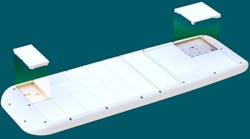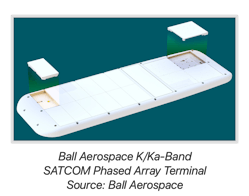Antennas for satellite-communications (satcom) Earth stations are usually recognized by their mechanically steered antennas with large dish-shaped reflectors. But that is about to change as Ball Aerospace will be teaming with innovative active antenna integrated-circuit (IC) developer Anokiwave to create much physically smaller satcom antennas that do all the steering electronically.
The collaboration brings together Anokiwave’s second-generation K/Ka-band active antenna ICs with Ball’s electronically steerable K/Ka-band antennas with no moving parts, resulting in outstanding satcom performance at those frequencies with expected military-grade reliability at relatively low manufacturing costs.
The electronically steered flat-panel antennas can be configured as groups of subarrays that are combined into a larger array antenna that provides performance that meets a customer’s most customized requirements. Combining subarrays provides the flexibility to modify a basic starting antenna design and allow a user to optimize performance to specific needs, without the expensive of starting a new antenna design. With the novel active antenna ICs, excellent performance is available with straightforward thermal management and digital control of antenna functions, such as tuning and beamforming.
“With our latest generation of satcom ICs, Anokiwave has improved the performance and reduced the cost to a point where Ball Aerospace can now deliver flat-panel electronically steered antennas that meet cost and performance targets,” said Abhishek Kapoor, Anokiwave vice president of sales. “This is a unique first in the industry as many companies have been working on solutions with promises made and broken, expectations set and not fulfilled. In the past, managing the delicate balance of cost and performance of the ICs has been a key challenge to the mass adoption of active antennas for satellite communications.”
Anokiwave, anokiwave.com; Ball Aerospace, ball.com

